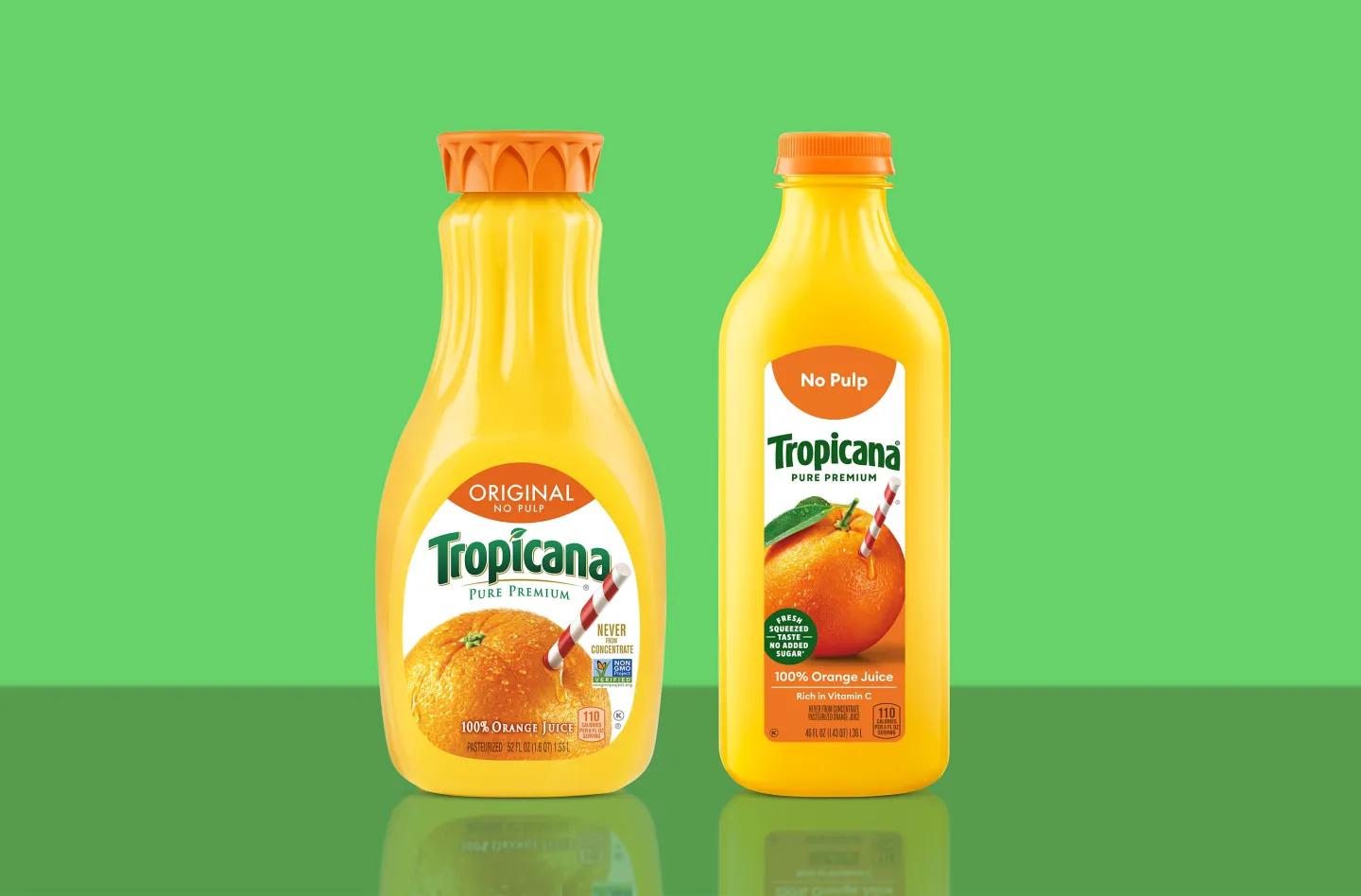
果汁品牌純果樂(Tropicana)費(fèi)了不少工夫去重新設(shè)計(jì)包裝,但是這番折騰卻起了反效果。今年夏天,純果樂重新設(shè)計(jì)了包裝瓶的形狀,將容量從52盎司“瘦身”到了46盎司,這番小動(dòng)作引發(fā)了消費(fèi)者的強(qiáng)烈不滿。大家紛紛在網(wǎng)上吐槽,并且威脅稱以后再也不會(huì)買了。這讓人不禁想起2009年那一次,純果樂也是因?yàn)橹匦略O(shè)計(jì)包裝而引發(fā)了銷量暴跌,那一次,純果樂也是不得不恢復(fù)到了最初的包裝設(shè)計(jì)。
現(xiàn)在的橙汁消費(fèi)者們對(duì)這種“減肥式漲價(jià)”(也就是容量變小但售價(jià)不變)十分敏感。雖然純果樂將新包裝橙汁定價(jià)為3.99美元一瓶,比舊款包裝便宜了約0.7美元,但是在部分零售商那里,新包裝橙汁的每盎司售價(jià)還是超過了舊包裝。比如在沃爾瑪,新包裝橙汁的售價(jià)折合每盎司7.7 美分,而老包裝的售價(jià)折合每盎司7.6美分。消費(fèi)者也注意到了這種“減肥式漲價(jià)”。
一位網(wǎng)民在社交平臺(tái)BlueSky上吐槽道:“以后再也不買純果樂了,這是典型的‘減肥式漲價(jià)’。這是我最后一次買這個(gè)牌子,是時(shí)候站出來,讓這些大公司知道我們是不好糊弄的了。真讓我惡心!”
純果樂的回應(yīng)
從2022年以來,美國(guó)消費(fèi)者就關(guān)注到了商品“減肥式漲價(jià)”的現(xiàn)象,不少品牌都想法設(shè)法通過縮減包裝尺寸來變相漲價(jià),尤其又以零食品牌為重災(zāi)區(qū)——比如多力多滋的玉米片包裝袋的容量從9.75盎司縮水到9.25盎司,通用磨坊的“家庭裝”可可泡芙和肉桂吐司脆的包裝盒也從19.3盎司“瘦身”到了18.1盎司。
純果樂需要擔(dān)心不是網(wǎng)民的吐槽,而是銷售額真的有可能會(huì)受到嚴(yán)重影響。畢竟上一次它搞這套小動(dòng)作的時(shí)候,銷售額在短短幾個(gè)月里就損失了將近20%。
純果樂品牌于2021年被百事公司出售給了私募股權(quán)公司PAI Partners,現(xiàn)在它的母公司是一家名叫純果樂品牌集團(tuán)的合資公司,因此它的銷售數(shù)據(jù)無法通過公開渠道獲得。但據(jù)CNN報(bào)道,來自消費(fèi)者研究公司Circana的數(shù)據(jù)顯示,在此次更改包裝設(shè)計(jì)后,純果樂的銷售額立即出現(xiàn)暴跌,僅8月份就下降了10.9%,到10月份已下降19%。
一位網(wǎng)友在Reddit上表示:“消費(fèi)者用錢包投票,這是最有力的抗議方式,但又是最不受品牌方重視的抗議方式,真是讓人無法理解。”
純果樂品牌集團(tuán)告訴《財(cái)富》,根據(jù)第三方數(shù)據(jù),純果樂的銷售額正在向正常水平回升。不過該公司也承認(rèn),消費(fèi)者需要時(shí)間來適應(yīng)包裝的變化。該公司還表示,此次更改包裝正是基于消費(fèi)者的反饋,目的是更方便顧客倒果汁和儲(chǔ)存果汁,同時(shí)也是為了使用一款含塑料更少、更環(huán)保的瓶蓋。
純果樂品牌集團(tuán)的一位發(fā)言人向《財(cái)富》表示:“據(jù)我們所知,有不少人反饋說,這些改變更適合他們,優(yōu)化了他們對(duì)我們產(chǎn)品的消費(fèi)體驗(yàn)。”
憤怒的消費(fèi)者
純果樂顯然消費(fèi)者的不滿情緒盡快緩和下來,以免重蹈15年前的覆轍。2009年初,該品牌光是換了一次包裝圖案,將包裝上一根吸管插在橙子上的圖片換成了一個(gè)盛著果汁的高腳杯的圖片,便引發(fā)了消費(fèi)者的強(qiáng)烈不滿,消費(fèi)者都認(rèn)為新包裝看起來毫無特色。
當(dāng)時(shí),一位憤怒的消費(fèi)者寫郵件給純果樂表示抗議:“你們這些搞包裝設(shè)計(jì)的人,真的有自己去買過橙汁嗎?我會(huì)買,而且這些新包裝難看死了!”
“高腳杯事件”給純果樂造成了大約3500萬美元的損失,也給整個(gè)果汁行業(yè)帶來了巨大沖擊。從次年1月1日到2月22日,純果樂的果汁銷量暴跌20%,銷售額下降19%。而它的競(jìng)爭(zhēng)對(duì)手佛羅里達(dá)天然公司(Florida’s Natural)和美汁源(Minute Maid)趁機(jī)在同期實(shí)現(xiàn)了兩位數(shù)的增長(zhǎng)。不久之后,純果樂就恢復(fù)了原來的包裝。
那次純果樂新包裝背后的設(shè)計(jì)師是彼得·阿內(nèi)爾,他曾在2008年給百事公司寫過一份長(zhǎng)達(dá)27頁的審美設(shè)計(jì)大綱,內(nèi)容洋洋灑灑,一會(huì)兒扯到蒙娜麗莎,一會(huì)兒扯到地球引力。阿內(nèi)爾為2009年純果樂包裝的新設(shè)計(jì)做了辯解。他說,之前的包裝只突出了橙子,但是沒有突出橙汁。而新設(shè)計(jì)的橙色瓶蓋 “從人體工程學(xué)的角度”暗示了鮮榨果汁時(shí)的擠壓過程——而且在阿內(nèi)爾看來,這個(gè)牛叉的設(shè)計(jì)的意義還遠(yuǎn)不止于此。
2009年,他在接受《廣告時(shí)代》采訪時(shí)表示:“我覺得‘?dāng)D’這個(gè)動(dòng)作是有情感寓意的,就像擁抱一樣,它象征著愛的力量,所以它可以讓人聯(lián)想到媽媽對(duì)子女的那種愛,對(duì)吧?”
阿內(nèi)爾并未及時(shí)回應(yīng)《財(cái)富》的置評(píng)請(qǐng)求。(財(cái)富中文網(wǎng))
譯者:樸成奎
果汁品牌純果樂(Tropicana)費(fèi)了不少工夫去重新設(shè)計(jì)包裝,但是這番折騰卻起了反效果。今年夏天,純果樂重新設(shè)計(jì)了包裝瓶的形狀,將容量從52盎司“瘦身”到了46盎司,這番小動(dòng)作引發(fā)了消費(fèi)者的強(qiáng)烈不滿。大家紛紛在網(wǎng)上吐槽,并且威脅稱以后再也不會(huì)買了。這讓人不禁想起2009年那一次,純果樂也是因?yàn)橹匦略O(shè)計(jì)包裝而引發(fā)了銷量暴跌,那一次,純果樂也是不得不恢復(fù)到了最初的包裝設(shè)計(jì)。
現(xiàn)在的橙汁消費(fèi)者們對(duì)這種“減肥式漲價(jià)”(也就是容量變小但售價(jià)不變)十分敏感。雖然純果樂將新包裝橙汁定價(jià)為3.99美元一瓶,比舊款包裝便宜了約0.7美元,但是在部分零售商那里,新包裝橙汁的每盎司售價(jià)還是超過了舊包裝。比如在沃爾瑪,新包裝橙汁的售價(jià)折合每盎司7.7 美分,而老包裝的售價(jià)折合每盎司7.6美分。消費(fèi)者也注意到了這種“減肥式漲價(jià)”。
一位網(wǎng)民在社交平臺(tái)BlueSky上吐槽道:“以后再也不買純果樂了,這是典型的‘減肥式漲價(jià)’。這是我最后一次買這個(gè)牌子,是時(shí)候站出來,讓這些大公司知道我們是不好糊弄的了。真讓我惡心!”
純果樂的回應(yīng)
從2022年以來,美國(guó)消費(fèi)者就關(guān)注到了商品“減肥式漲價(jià)”的現(xiàn)象,不少品牌都想法設(shè)法通過縮減包裝尺寸來變相漲價(jià),尤其又以零食品牌為重災(zāi)區(qū)——比如多力多滋的玉米片包裝袋的容量從9.75盎司縮水到9.25盎司,通用磨坊的“家庭裝”可可泡芙和肉桂吐司脆的包裝盒也從19.3盎司“瘦身”到了18.1盎司。
純果樂需要擔(dān)心不是網(wǎng)民的吐槽,而是銷售額真的有可能會(huì)受到嚴(yán)重影響。畢竟上一次它搞這套小動(dòng)作的時(shí)候,銷售額在短短幾個(gè)月里就損失了將近20%。
純果樂品牌于2021年被百事公司出售給了私募股權(quán)公司PAI Partners,現(xiàn)在它的母公司是一家名叫純果樂品牌集團(tuán)的合資公司,因此它的銷售數(shù)據(jù)無法通過公開渠道獲得。但據(jù)CNN報(bào)道,來自消費(fèi)者研究公司Circana的數(shù)據(jù)顯示,在此次更改包裝設(shè)計(jì)后,純果樂的銷售額立即出現(xiàn)暴跌,僅8月份就下降了10.9%,到10月份已下降19%。
一位網(wǎng)友在Reddit上表示:“消費(fèi)者用錢包投票,這是最有力的抗議方式,但又是最不受品牌方重視的抗議方式,真是讓人無法理解。”
純果樂品牌集團(tuán)告訴《財(cái)富》,根據(jù)第三方數(shù)據(jù),純果樂的銷售額正在向正常水平回升。不過該公司也承認(rèn),消費(fèi)者需要時(shí)間來適應(yīng)包裝的變化。該公司還表示,此次更改包裝正是基于消費(fèi)者的反饋,目的是更方便顧客倒果汁和儲(chǔ)存果汁,同時(shí)也是為了使用一款含塑料更少、更環(huán)保的瓶蓋。
純果樂品牌集團(tuán)的一位發(fā)言人向《財(cái)富》表示:“據(jù)我們所知,有不少人反饋說,這些改變更適合他們,優(yōu)化了他們對(duì)我們產(chǎn)品的消費(fèi)體驗(yàn)。”
憤怒的消費(fèi)者
純果樂顯然消費(fèi)者的不滿情緒盡快緩和下來,以免重蹈15年前的覆轍。2009年初,該品牌光是換了一次包裝圖案,將包裝上一根吸管插在橙子上的圖片換成了一個(gè)盛著果汁的高腳杯的圖片,便引發(fā)了消費(fèi)者的強(qiáng)烈不滿,消費(fèi)者都認(rèn)為新包裝看起來毫無特色。
當(dāng)時(shí),一位憤怒的消費(fèi)者寫郵件給純果樂表示抗議:“你們這些搞包裝設(shè)計(jì)的人,真的有自己去買過橙汁嗎?我會(huì)買,而且這些新包裝難看死了!”
“高腳杯事件”給純果樂造成了大約3500萬美元的損失,也給整個(gè)果汁行業(yè)帶來了巨大沖擊。從次年1月1日到2月22日,純果樂的果汁銷量暴跌20%,銷售額下降19%。而它的競(jìng)爭(zhēng)對(duì)手佛羅里達(dá)天然公司(Florida’s Natural)和美汁源(Minute Maid)趁機(jī)在同期實(shí)現(xiàn)了兩位數(shù)的增長(zhǎng)。不久之后,純果樂就恢復(fù)了原來的包裝。
那次純果樂新包裝背后的設(shè)計(jì)師是彼得·阿內(nèi)爾,他曾在2008年給百事公司寫過一份長(zhǎng)達(dá)27頁的審美設(shè)計(jì)大綱,內(nèi)容洋洋灑灑,一會(huì)兒扯到蒙娜麗莎,一會(huì)兒扯到地球引力。阿內(nèi)爾為2009年純果樂包裝的新設(shè)計(jì)做了辯解。他說,之前的包裝只突出了橙子,但是沒有突出橙汁。而新設(shè)計(jì)的橙色瓶蓋 “從人體工程學(xué)的角度”暗示了鮮榨果汁時(shí)的擠壓過程——而且在阿內(nèi)爾看來,這個(gè)牛叉的設(shè)計(jì)的意義還遠(yuǎn)不止于此。
2009年,他在接受《廣告時(shí)代》采訪時(shí)表示:“我覺得‘?dāng)D’這個(gè)動(dòng)作是有情感寓意的,就像擁抱一樣,它象征著愛的力量,所以它可以讓人聯(lián)想到媽媽對(duì)子女的那種愛,對(duì)吧?”
阿內(nèi)爾并未及時(shí)回應(yīng)《財(cái)富》的置評(píng)請(qǐng)求。(財(cái)富中文網(wǎng))
譯者:樸成奎
Tropicana is about to learn if the juice is worth the squeeze. Customers are revolting after the orange juice juggernaut redesigned the shape of its bottles this summer, slimming them from 52 to 46 ounces. The backlash on social media and threats to no longer buy the product is reminiscent of a disastrous 2009 rebrand that sent sales plummeting, forcing Tropicana to revert to its original design.
This time around, orange juice-drinkers are wary of shrinkflation, or product sizes reducing while prices stay the same. Indeed, while Tropicana has set the price of its new bottles at $3.99, about 70 cents cheaper than its old design, the slim bottles are still more expensive per ounce than the older ones in some retailers. At Walmart, the new, 46-ounce bottles cost 7.7 cents per ounce, while the 52-ounce bottles retail for 7.6 cents per ounce. Consumers have taken notice of the alleged shrinkflation.
“Done with Tropicana. Classic Shrinkflation,” one BlueSky user said. “Last time it comes into this house. Time to stand up and let these big corporations know that we actually DO count. Sickens me.”
Tropicana responds to shrinkflation allegations
Shrinkflation has been a growing concern for consumers since 2022, when brands tried to hide the impact of inflation by strategically reducing package sizes instead of hiking up prices. Snack brands—even favorite cereals—have been the worst alleged perpetrators of shrinkflation, with Doritos bags shrinking from 9.75 ounces to 9.25 ounces, and “family size” boxes of General Mills’ Cocoa Puffs and Cinnamon Toast Crunch contracting from 19.3 ounces to 18.1 ounces over the course a few months in 2022.
But it’s not the social media ire that should concern Tropicana, but rather the threat of sales being washed down the drain. After all, the last redesign that soured customers resulted in a nearly 20% sales loss in just a few months.
Tropicana, which PepsiCo sold in 2021 to private equity firm PAI Partners, is now owned by joint venture Tropicana Brands Group, meaning its sales data is not publicly available; but according to consumer research firm Circana,Tropicana sales plummeted immediately after the switch, dropping 10.9% in August, and 19% by October, CNN reported.
“Consumers voting with their wallets is the most powerful and underrated form of protesting. Incredible,” one user commented on Reddit.
Tropicana Brands Group told Fortune that, according to third-party data, sales are returning to normal levels, though acknowledged it takes time for consumers to adapt to packaging changes. The company made the change—informed by customer feedback—to make the bottle easier to pour and store, as well as to produce a more sustainable cap using less plastic.
“Anecdotally, we are hearing from many that the changes better suit them and optimize their experience with our product,” a Tropicana Brands Group spokesperson told Fortune in a statement.
Tropicana’s sour customers
Tropicana will hope customers’ bitterness about the change sweetens, so as not to repeat the fallout of its redesign efforts 15 years ago. In early 2009, the juice brand switched its packaging from displaying an orange with a straw in it to an image of a tall glass of juice. Customers panned the change, complaining the bottles looked generic.
“Do any of these package-design people actually shop for orange juice?” one angry email-writer wrote to the company at the time. “Because I do, and the new cartons stink.”
The design tweak, estimated to have cost Tropicana $35 million, had a seismic shift on the juice industry. Not only did Tropicana unit sales plummet 20% from Jan. 1 to Feb. 22 following the rebrand, but dollar sales dropped 19%. Tropicana competitors Florida’s Natural and Minute Maid saw double-digit unit sales boosts in the same two-month period. Tropicana reverted to its original package soon after.
Peter Arnell, the designer behind Tropicana’s rebrand—who was also responsible for Pepsi’s metaphysical 27-page redesign outline in 2008 invoking the Mona Lisa and the earth’s gravitational pull—justified the 2009 packaging change. He questioned why the orange, but never the juice, was previously featured on Tropicana’s packaging. The new design’s orange twist cap “implied ergonomically” the squeezing motion that is required in making juice—and, in Arnell’s eyes, so much more.
“‘Squeeze’” maintains a certain level of, I guess, power when it comes to this notion emotionally about what squeeze means,” he told AdAge in 2009. “Like, ‘my squeeze.’ or ‘give me a squeeze,’ or the notion of a hug, or the ideas behind the power of love and the idea of transferring that love or converting that attitude between mom and the kids, right?”
Arnell did not respond to Fortune’s request for comment.






